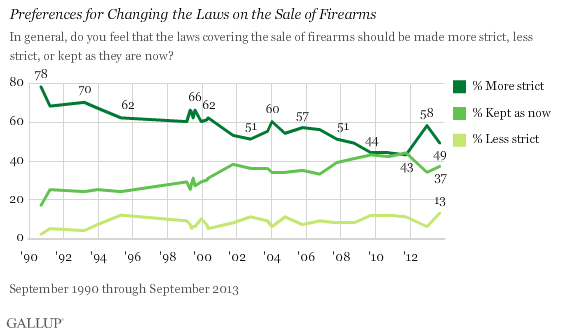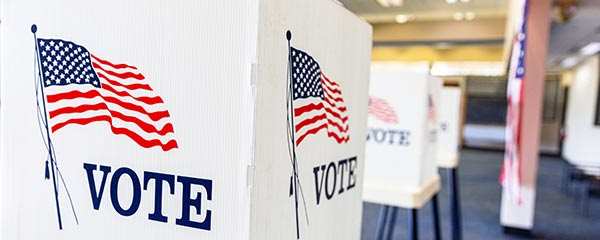PRINCETON, NJ -- Forty-eight percent of Americans blame the mental health system "a great deal" for mass shootings in the United States, unchanged from January 2011. At the same time, fewer blame easy access to guns now (40%) than two years ago (46%), making the mental health system the perceived top cause of mass shootings.
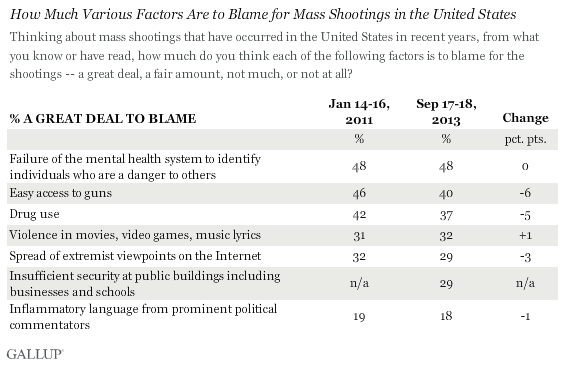
Gallup conducted the new poll Sept. 17-18, the two days immediately after a shooting at the Washington Navy Yard in Washington, D.C., in which, apparently, a lone gunman -- a government contractor and former Navy reservist -- went on a rampage, killing 12. Much of the news coverage has focused on the shooter's questionable mental state in the days, weeks, and even years leading up to Monday's events.
The January 2011 trends reflect public opinion shortly after a massacre in Tucson, Ariz., in which six people were killed and 12 others wounded, including U.S. Rep. Gabrielle Giffords.
Drug use remains the third-highest-ranking factor in gun violence, according to Americans, although, at 37%, the proportion blaming it is down five points from January 2011. Closer to three in 10 blame violence in movies, video games, and music, as well as extremist views on the Internet, and lack of building security. Now, as in 2011, relatively few -- less than 20% -- put heavy blame on inflammatory language by prominent political commentators.
Beyond those blaming the mental health system "a great deal," another 32% blame it "a fair amount," resulting in 80% total blame. This contrasts with a combined 61% blaming guns and 66% blaming drugs. Slim majorities assign at least a fair amount of blame to violence in the entertainment industry (56%), extremism on the Internet (57%), and deficient building security (58%), but fewer than half view heated political talk as a key culprit.
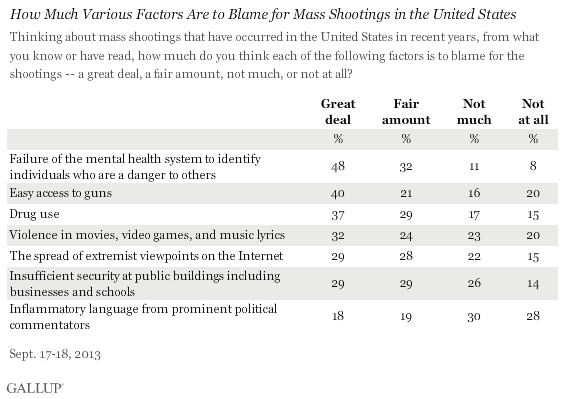
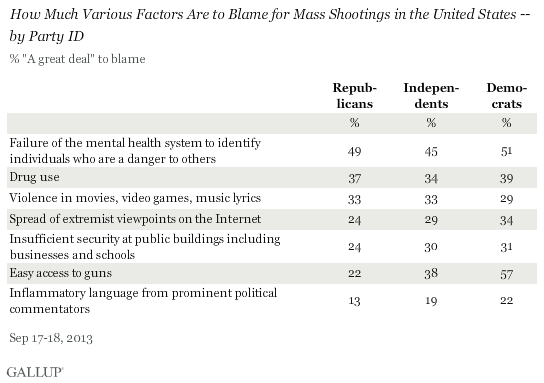
Call for Stricter Gun Laws Is Down Post-Newtown, but Higher Than Two Years Ago
Even as the Washington Navy Yard shooting produced renewed calls for gun control from some quarters, fewer Americans today than in December 2012 -- 49% vs. 58% -- believe the laws governing the sale of firearms should be made stricter. The 2012 poll was conducted immediately after the December 2012 Newtown, Conn., mass shooting, in which a mentally disturbed young man killed 27, most of them first graders.
The current result represents just slightly more support for stricter laws than Gallup found between 2009 and 2011.
Thirteen percent of Americans now say gun laws should be made less strict, up from 6% in December, and the highest in Gallup's trend dating to 1990, which can be found on page 2.
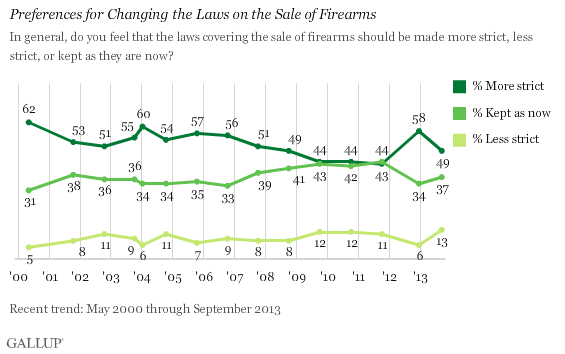
Bottom Line
While guns are a common denominator in the high-profile mass shootings that have shaken the nation in recent years, another has been the mentally unstable individuals committing the crimes. The Washington Navy Yard case shares this element with some of the most familiar massacres of recent decades, including those occurring in Newtown, Conn.; Aurora, Colo.; Oak Creek, Wisc.; Tucson, Ariz.; and Littleton, Colo., as well as at Virginia Tech. Many of these cases involve stories of failures in mental health systems to raise sufficient red flags about the risk the ultimate perpetrators could represent.
Since the watershed tragedy in Newtown, policymakers at the federal and state levels have attempted to address both factors -- guns and the mental health system. And the public has shown broad support for aspects of these initiatives, including many of President Barack Obama's 2013 proposals to address gun violence. However, the current results support longstanding evidence from Gallup polling that Americans believe more can be done on the mental health side.
As long ago as 2007, in reference to the Virginia Tech shootings, Americans' unaided responses to how such events could be prevented included many more references to screening and monitoring students for mental health problems than to changing the gun laws. In the same vein, today Americans are more likely to believe the mental health system is to blame than gun laws, a slight shift from 2011, and support for stricter gun laws is down from the surge of support seen right after Newtown.
Finally, while past Gallup polls have found Americans broadly supportive of enhancing school security, including with armed guards, as a way to prevent shootings, and 58% think lack of building security is at least partially responsible for mass shootings, relatively few -- 29% -- see it as a prime causal factor.
Survey Methods
Results for this Gallup poll are based on telephone interviews conducted Sept. 17-18, 2013, with a random sample of 1,023 adults, aged 18 and older, living in all 50 U.S. states and the District of Columbia.
For results based on the total sample of national adults, one can say with 95% confidence that the margin of sampling error is ±4 percentage points.
Interviews are conducted with respondents on landline telephones and cellular phones, with interviews conducted in Spanish for respondents who are primarily Spanish-speaking. Each sample of national adults includes a minimum quota of 50% cellphone respondents and 50% landline respondents, with additional minimum quotas by region. Landline and cell telephone numbers are selected using random-digit-dial methods. Landline respondents are chosen at random within each household on the basis of which member had the most recent birthday.
Samples are weighted to correct for unequal selection probability, nonresponse, and double coverage of landline and cell users in the two sampling frames. They are also weighted to match the national demographics of gender, age, race, Hispanic ethnicity, education, region, population density, and phone status (cellphone only/landline only/both, and cellphone mostly). Demographic weighting targets are based on the March 2012 Current Population Survey figures for the aged 18 and older U.S. population. Phone status targets are based on the July-December 2011 National Health Interview Survey. Population density targets are based on the 2010 census. All reported margins of sampling error include the computed design effects for weighting.
In addition to sampling error, question wording and practical difficulties in conducting surveys can introduce error or bias into the findings of public opinion polls.
View methodology, full question results, and trend data.
For more details on Gallup's polling methodology, visit www.gallup.com.
